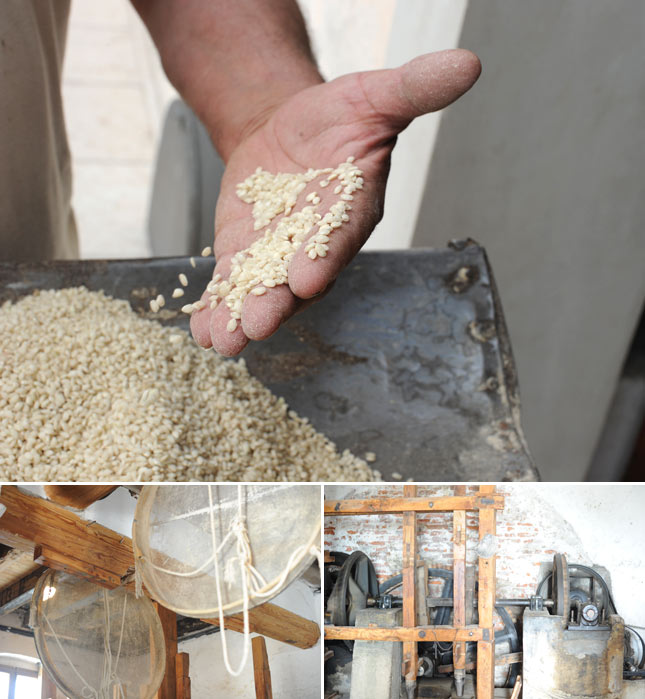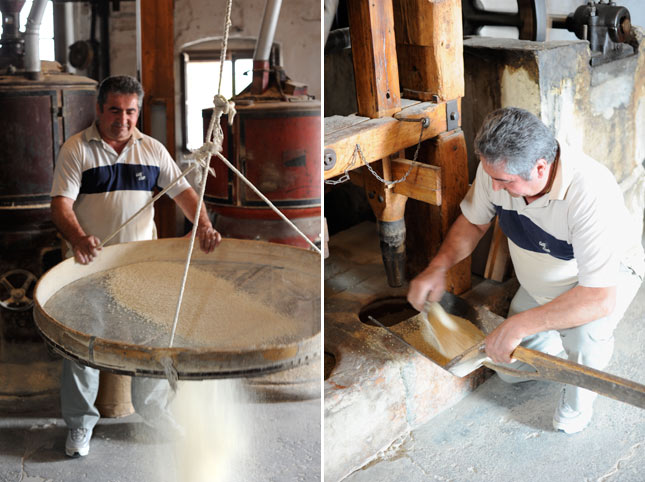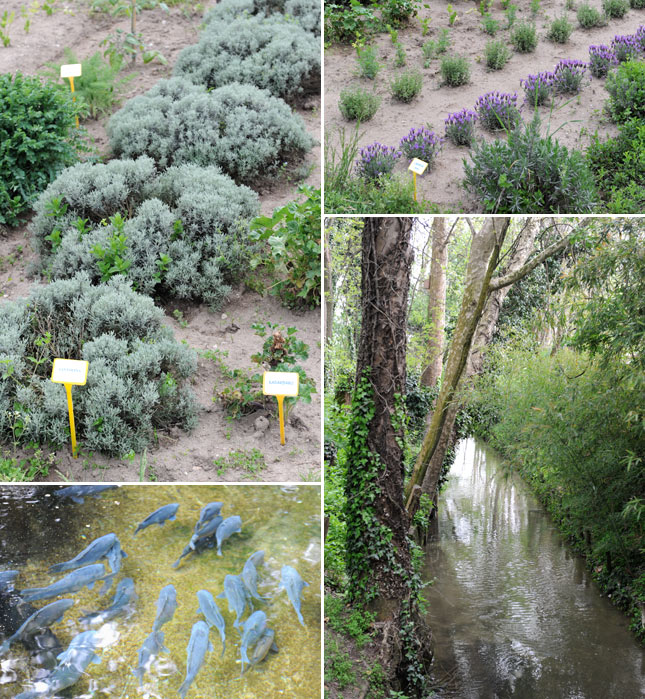
Ever imaginative, Italy is the only Western nation to make a movie devoted to rice. It is called Riso Amore (1949). The title literally means ‘bitter rice’ but is a bit of word play that can also mean ‘bitter laughter.’ The movie stared Sylvia Mangano (1930 - 1989) as “Sylvia,” the mondina, or a woman who picks weeds in rice fields. The leggy Sylvia falls for a gangster and by the end of the film there is a lot to laugh bitterly about. Off screen Mangano had little to be bitter about, she had a long career and a long marriage to famed producer Dino de Laurentiis. Her grand-daughter is food show hostess Giada de Laurentiis.
The popularity of Riso Amore drew attention to the lives of the mondine and the rice fields of the Po Valley. The mondine, or the ‘women who went to the rice’ were some of the last in a long line of Italian peasants. This now vanished strata of itinerant workers labored for roughly a century that ended in the late 1950’s. As one might expect, working conditions were unpleasant. Rice planting is sweaty, back-breaking work with hands and feet submerged in mud. The still water meant the mosquitos and frogs were plentiful while the pay was not. And, as the age of the mondine was a time of less-then-subtle Communist leanings, the work was politicized, romanticized and bureaucratized.

To allay the tedium of their work the mondine sang. Some of the more popular songs were: O Marinaio Che Cosa Rimiri? (O Sailor, When Are You Coming Back?), Lavoro è Molto Poco (Work Doesn't Amount to Much) and, La Mia Mamma L'è 'Na Ruffiana (My Mama was a Hooker). One of the most sung songs was, La Morte di Una Mondina (The Death of a Mondina), a musical tribute to a slain field worker named Maria Margotti. In those factional, highly charged, political times the sacrificial Margotti was remembered in song as a martyr to the cause of worker’s rights.
So how did rice, the popular subject of movie and song as well as a non-native cereal grain that requires enormous effort to cultivate, come to be such a high-profile staple in Italian culture and cuisine?
There are so many possible answers to this question that perhaps it is best just to say no one really knows. It is certain that the grain was available in Roman times though it was used exclusively for medicines often mixed with honey or wines. In the 10th century records show that rice moved through Sicily en route to Spain by Arab traders who were introduced to the grain by Indians. In true Sicilian fashion it is likely that a portion of this rice shipment was appropriated, shall we say, and began its slow agronomical climb north. Sometime between the 13th and 14th centuries the plains of northern Italy’s Po Valley were cleared for agriculture and grazing and starting around 1475 rice begins to appear on invoices and tax documents with regularity.
Evidently the rice business took off quickly in the north of Italy. By 1533 changes in Venetian law ended the excise tax on rice because it was considered a vegetable and in 1590 Lombardy enacted one of the earliest child labor laws to keep children out of the rice fields. Other evidence of the budding popularity of rice is its appearance in cookbooks. A 14th century recipe called rixo in bona manera is rice boiled in almond milk then topped with sugar. (From this dish comes the Italian expression applied to giggly people: “Che aveva mangiato la minestra di riso.” Translated: He has eaten laughter/rice soup). According to legend the dish we now know as risotto Milanese came into being in 1574 when a stained glass artist named Valerius tinted the local rice dish with the same saffron he used to color glass.

It wasn’t until after the end of WWII that Italy diversified its rice production and the industry grew to the degree that the nation is now the largest producer of rice in Europe.¹ The lone type of rice grown for centuries was called “nosetrale” and may have remained alone had it not been for a Dominican friar who smuggled in other species of rice from the Philippines. It is tough to pinpoint a year in which something is smuggled but it appears that this religious rice trafficking took place in the early 1830’s. The Dominican order planted a test field to determine which rices produced the highest yields and were most resistant to disease. By the middle of the 20th century the weed picking mondine were gone, replaced by better crop management techniques, herbicides, bug-eating carp, row-lining laser beams and machines.
Italian riso is a short grain rice that falls into four categories based on grain size. Large to small they are: commune, semifino, fino, and superfino. The superfino rice is the size of rice most used for risotto though each variety has its own merits when it comes to the thickness, starchiness or soupiness in the risottos it produces. Often used varieties of Italian rice are: Aborio, Carnaroli, popular in Venice, Baldo and Vialone Nano. The Vialone Nano variety grown in the Province of Verona has been given Indicazione Geografica Protetta - IGP (Protected Geographical Indication - PGI) status by the European Union. The IGP statement from the European Commission on Agricultural and Rural Development reads: “Quality is an issue for every farmer and buyer... EU law lays down stringent requirements guaranteeing the standards of all European products… EU quality schemes identify products and foodstuffs farmed and produced to exacting specifications.”
Growing and milling the Vialone Nano rice outside of a town called Isola della Scalla (9.3 miles /15 kilometers south of Verona) are the brothers Gabriele, the jet-setting chef and Maurizio, the logistical and operational overseer, Ferron. The Ferron brothers are sixth generation rice farmers and continue to mill their grain at the Pila Vechia, a facility that went into operation in 1650. The same water driven mill wheel, turned by the passing Zenobio Creek, drives the pestle that pounds the grains to remove the hulls to make white rice. With such equipment, along with another huller built in 1950, the process of refining their rice is slow and painstaking. The end result is a simple, clean, rice grain that has not been subjected to any treatment apart from the abrasion necessary to remove the hull.
The rice produced at Pila Vechia has been part of the local economy and lore for centuries. In its earliest, semi-feudal times the farm was managed as a fief and supported the many families who worked the paddies. In the days of the Risorgimento (Italian unification) the rice was a staple in the diets of Veronese radicals, moderates, unitarians, federalists, republicans and monarchists. During the Second World War the farm was saved from being bombed due to the proximity of a British prisoner of war camp. Able to bring in harvests during wartime the farm fed many nearby families and the POWs. Today the Ferrrons have expanded the scope of their efforts and regularly consult and visit with rice farmers in Africa and Asia on how to increase yields, farm cleanly and improve the nutritional value of the food they grow. They also offer lessons on how to make the perfect risotto and have two restaurants offering tasting menus with wine pairing.
There are as many ways to prepare rice in Italy as there are kitchens. Oftentimes cooks utilize the ideal combinations of their local ingredients to produce plates both savory or sweet, appetizer or main, even dessert. The recipe below is courtesy of the Ferrons. It is the traditional risotto dish of Isola della Scala.

Chef Gabriele Ferron’s Risotto All’Isolana
4 large portions
4 cups (400 grams) Vialone Nano rice
3 1/3 cups (8 decilitres) vegetable broth, boiling hot
3 1/3 cups (8 decilitres) chicken broth, boiling hot
¼ pound (100 grams) pork loin, minced or ground
¼ pound (100 grams) lean veal, minced or ground
2 ounces (60 grams) butter
2 ounces (60 grams) grated Parmigiano cheese
2 tablespoons extra virgin olive oil
1/2 cup (1 decilitre) cognac or dry, unoaked white wine (pinot grigio works well)
1 sprig rosemary
salt & pepper to taste
ground cinnamon (optional)
In a pot melt the butter over low flame with the rosemary sprig. When the butter is golden, remove the rosemary and add the two meats and the cognac and raise the heat to medium. Cook a few minutes, add salt and pepper to taste, then continue cooking on low until the meat is done.
To a large saucepan heated on low add the olive oil and rice and let the rice toast a few minutes. Add the broth, stir gently, cover and simmer for 10 minutes. Add meat and recover, cooking until the broth is completely absorbed. Remove from the heat. Replace lid with a clean kitchen towel and let sit for 2-3 minutes. Add the cheese and optional cinnamon and stir gently. Serve on single plates or in a large serving dish.
Where to find Ferron rice in the US:
A.G Ferrari & Sons
Contact information:
Antica e Rinomata Riseria Ferron
Via Torre Scaligera, 9
37063 Isola della Scala, VR
Italia
+39 045 730 1022
www.risoferron.com
1.) Italy is also the largest grower of kiwis in Europe. For more on Italian kiwi crops see: New Zealand’s Little Green Goddess on this site.